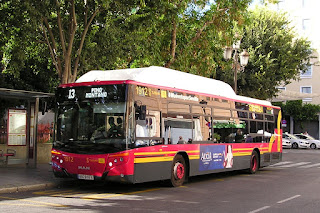Seville, the capital of Andalusia, is situated on the lower reaches of the Guadalquivir River and is the fourth-largest city in Spain with a population of 705,325. The transport network is under the management of TUSSAM (Transportes Urbanos de Sevilla, Sociedad Anónima Municipal), a public company established in 1975 and belonging to the City.
TUSSAM 170, 7934 FSV a CNG fuelled Irisbus 491E.12.27 CityClass with Noge Cittour body, new in 2007, operating route 34 on the narrow one-way Calle Trajano.
TUSSAM 1912, 8979 KFK Man NL 313F CNG with Castrosua CS40 City Versus II body in Plaza del Duque, on route 13.
TUSSAM tram 304 with the pantograph down sits under the rapid charge point on Avenue de la Constitucion. The five Urbos 3 articulated trams manufactured by CAF and delivered in 2011 run in battery mode on the catenary free section.
DAMAS 1746 KW a Volvo B7BLE with Sunsundegui Astral body departs Plaza de Armas Bus Station on service 174 to Gines, a twenty minute journey to the west of Seville.
Sevirama
British Fleet
New To
|
Fleet No.
|
Original
Registration
|
Chassis
|
Chassis No.
|
Body
|
Body No.
|
Original Seating
|
Current Seating
|
Current
Registration
|
Previous
Registration
|
598
|
GVO 718N
|
7403880
|
4013
|
H47/31D
|
O47/29C
|
SE-0032-BX
|
||||
572
|
OTO 572M
|
7302665
|
2534
|
H47/30D
|
O47/29C
|
SE-4063-BU
|
SE-2211-R2
|
|||
575
|
OTO 575M
|
7304430
|
2536
|
H47/30D
|
O47/29C
|
SE-4064-BU
|
SE-2213-R2
|
|||
592
|
GTO 332N
|
7404624
|
4007
|
H47/31D
|
O47/29C
|
SE-4065-BU
|
SE-2212-R2
|
|||
591
|
GCR 881N
|
7404342
|
4006
|
H47/31D
|
O47/29C
|
SE-4066-BU
|
SE-2214-R2
|
|||
AN233
|
JPE 233V
|
7905103
|
Roe
|
GO
8287
|
H43/30F
|
O43/30C
|
SE-6277-DL
|
Sevirama SE-4065-BU, former Nottingham Leyland Atlantean GTO 332N stands at Plaza del Duque de la Victoria. Following close behind is a Volvo B9TL/Unvi Urbis of Compania Hispalense de Transvias in City Sightseeing colours.
DAMAS 453, 8318 KGS, Iveco Magelys PRO 12.2m, VIN VNE7257RX00002195, new in 2017. The DAMAS business originates from the 1920s when it first transported passengers between Ayamonte and Huelva. Today the business is the largest coach and bus company in Huelva province. Currently six national routes and one international route (Lagos, Portugal) are operated from Plaza de Armas Bus Station.
Seville is more than just oranges. A split city with the
old centre located on the east bank and the modern heart located around the
still very much in tact Expo92 site on the west bank, it provides plenty of
opportunities for the casual visitor and transport enthusiast.
ALSA 3020, 7379 HBH, Mercedes Benz Travego 17RHD (WEB63224713102887), new in 2010, sits at traffic lights about to turn into Calle Torneo, having just departed Plaza de Armas Bus Station. The destination blind shows route licence VJA-160 for service M-364.
ALSA Spain became part of the British owned National Express Group in 2005. The company can trace its history back to the 18th century but it wasn’t until 1923 the company Automobiles Luarca, SA (ALSA) was formed. Today it has a modern fleet of 3,465 buses, 9,719 staff and transport more than 358 million passengers per year.
TUSSAM 1056, Castrosua bodied Iveco Cityclass on Avenue Carlos V. The tram overhead wires are visible in the background on the segregated track, within a few yards the tram crosses a roundabout and the overhead wires cease.
TUSSAM 2475 KPS Mercedes Benz Sprinter City 65.77 in Plaza del Duque, on route C5 a circular route inside the old city.
ALSA 3020, 7379 HBH, Mercedes Benz Travego 17RHD (WEB63224713102887), new in 2010, sits at traffic lights about to turn into Calle Torneo, having just departed Plaza de Armas Bus Station. The destination blind shows route licence VJA-160 for service M-364.
ALSA Spain became part of the British owned National Express Group in 2005. The company can trace its history back to the 18th century but it wasn’t until 1923 the company Automobiles Luarca, SA (ALSA) was formed. Today it has a modern fleet of 3,465 buses, 9,719 staff and transport more than 358 million passengers per year.
TUSSAM 1056, Castrosua bodied Iveco Cityclass on Avenue Carlos V. The tram overhead wires are visible in the background on the segregated track, within a few yards the tram crosses a roundabout and the overhead wires cease.
TUSSAM 2475 KPS Mercedes Benz Sprinter City 65.77 in Plaza del Duque, on route C5 a circular route inside the old city.









No comments:
Post a Comment